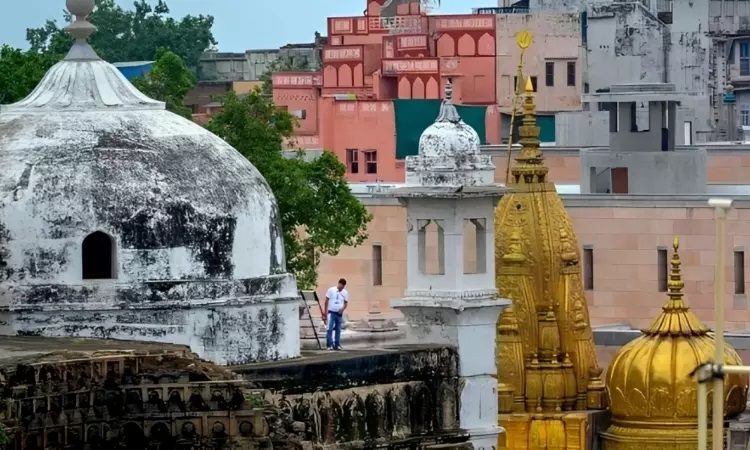
A fresh application has been filed before the Court of District Judge, Varanasi to “seal and protect” certain areas of Gyanvapi Mosque premises where Hindu Signs and symbols exist so that “no damage can be done to the same by Anjuman Masjid Committee and Namaz offerers”.
The application also seeks a direction to concerned respondent authorities to make a regulation to restrict and regulate the number of Namaz Offerers at the disputed site and a direction to the Anjuman Committee to refrain from any dying and painting the structures inside Gyanvapi mosque premises.
This application has been filed 3 days after the Allahabad High Court allowed the withdrawal of a Public Interest Litigation (PIL) plea seeking a direction to the Uttar Pradesh Government to seal the entire Gyanvapi Mosque premises w/o affecting the ASI Survey order of the Varanasi Court that has been upheld by both, the Allahabad HC and the Supreme Court.
The application, filed under Order 39 Rule 1 Of the CPC, has been filed by Rakhi Singh (through Advocates Saurabh Tiwary and Anupam Dwivedi) in the Shringar Gauri Worshipping suit 2022 (presently pending before the Varanasi Court).
This Suit was filed last year by 4 Hindu Women Worshippers (including Singh) seeking year-round access to worship inside the Mosque premises.
In the application it has been claimed that at the disputed site (settlement Plot No. 9130 Ward and PS- Dashaswamedh, District Varanasi), a magnificent temple used to exist, wherein Lord Shiva, the Lord of Universe, himself established the “Jyotirlinga” lakhs of years ago, however, the said temple was damaged/destroyed in the year 1669 by “cruel Islamic” ruler Aurangzeb.
The application further states that after destroying the said temple, Muslims unauthorizedly encroached into the temple premises and put a super structure which they call the “alleged Gyanvapi Mosque” even though the property was vesting in the deity and the same was not and could not be a Waqf Property.
It also contends that the disputed property has been vesting in the Deity since time immemorial and if any person or persons forcibly and without authority of law offer namaz within that property or at a particular place, the same cannot be called as mosque.
Further, the application refers to certain pieces of evidence, sign/symbols on walls, and pillars inside the Gyanvapi Mosque premises to argue that same are part of the old Hindu Temple and that the present structure is standing on the plinth and base of the old temple structure.
In this regard, the application further refers to the report of an Advocate commission (which surveyed the disputed property in Mya last year) to claim that it found various signs of Hindu Dharm like Trident, Swastika, Lotus and other Hindu signs which is “sufficient to prove the existence of Hindu Temple” at the disputed site.
Significantly, the application claims that defendant No. 4 (Anjuman Mosque Committee) is trying to destroy and damage the Hindu sign and symbols existing in the Gyanvapi premises which is a very important piece of evidence for trial and deciding the present suit.
Against this backdrop, the Application seeks a direction to “seal and protect” certain areas of Gyanvapi Mosque premises where all such Hindu Signs and symbols exist, as were found in the Advocate Commissioners survey last year as well as whatever Hindu Sign and Symbol would be found during the ongoing ASI survey.
In related news, the Varanasi District Judge earlier this week prohibited the electronic and print media from publishing any ‘unofficial news’ about the ongoing ASI survey of Gyanvapi Mosque premises. The Court has further directed both parties to the Shringar Gauri Worshipping suit of 2022 and the ASI Officials to abstain from giving any statements regarding the survey to the media.
It may be noted that the ASI is presently conducting a scientific survey of the Gyanvapi complex in Varanasi as per the July 21 order of the Varanasi District Judge to determine if the mosque was constructed over a pre-existing structure of a Hindu temple. Today is the eighth consecutive day of the survey.
Source: LiveLaw




